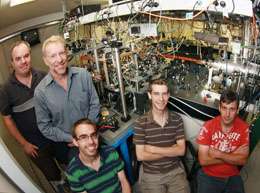Scientists show atoms act like lasers

(PhysOrg.com) -- Scientists from The Australian National University have developed an atom laser that behaves exactly like a light laser, opening up new possibilities in things like holograms.
The research team, led by Dr Andrew Truscott of the ARC Centre of Excellence for Quantum-Atom Optics at ANU, have shown for the first time that a beam of helium atoms can be made to have properties similar to a laser light beam. The study confirms, for atoms, a theory first developed for light nearly 50 years ago by the 2005 Nobel Prize winner in physics, Roy Glauber. The work was done with PhD students Sean Hodgman and Andrew Manning and the paper on their research is published today in Science.
“Lasers have a property called coherence, which means that the particles of light – or photons – all march in step,” said Dr Truscott.
“If you measure the time between the arrivals of the photons in a laser beam, you find that the photons are randomly spaced, with all arrival times between photons equally probable.
“On the other hand, incoherent sources – such as a light bulb – exhibit what is called photon bunching, where it is more likely that photons arrive within a short space of time of each other. This bunching in an incoherent light source is manifested by photons arriving in pairs – what’s known as second order – or in triplets – third order,” he said.
By making atoms extremely cold – within one millionth of a degree of absolute zero – the scientists forced the atoms to march in step and created an atom laser beam that behaves exactly like a laser beam of photons.
“Our experiment shows – for the first time – that the same second and third order coherence properties also apply to atoms,” said team member Professor Ken Baldwin. “This very cold atom laser also had a random distribution of arrival times with no bunching – indicating that it was perfectly coherent.”
Fellow team member Dr Robert Dall added that by warming up the atoms the research team showed that the atoms no longer behaved coherently, and they once again exhibited bunching in pairs and triplets.
“These experiments demonstrate that an atom laser behaves coherently like a light laser, and may help in developing similar applications, such as holography,” said Dr Dall.
Provided by Australian National University

















